A Study of Shock-Metamorphic Features of Feldspars from the Xiuyan Impact Crater
Abstract
1. Introduction
2. Sample and Methods
3. Results
3.1. Petrology of Impact Breccias
3.2. Weakly Shocked Feldspar
3.3. Moderately Shocked Feldspar
3.4. Strongly Shocked Feldspar
3.5. Mixed Melt Glass
4. Discussion
4.1. Estimation of Shock Pressure
4.2. Diaplectic Feldspar Glass or Maskelynite?
4.3. Raman Spectrum of Shocked Feldspars
4.4. Formation Process of Glass
5. Conclusions
Author Contributions
Funding
Acknowledgments
Conflicts of Interest
References
- Nesse, W.D. Introduction to Mineralogy, 3rd ed.; Oxford University Press: Oxford, UK, 2017; pp. 249–255. [Google Scholar]
- Rubin, A.E.; Ma, C. Meteoritic minerals and their origins. Chem. Erde-Geochem. 2017, 77, 325–385. [Google Scholar] [CrossRef]
- Gucsik, A. Shock metamorphism at terrestrial impact structures: Mineralogical and geological consequences. Acta Mineral. Petrol. 2008, 48, 17–31. [Google Scholar]
- Stöffler, D. Zones of impact metamorphism in the crystalline rocks of the Nördlinger Ries crater. Contrib. Mineral. Petrol. 1966, 12, 15–24. [Google Scholar] [CrossRef]
- Pickersgill, A.E.; Osinski, G.R.; Flemming, R.L. Shock effects in plagioclase feldspar from the Mistastin Lake impact structure, Canada. Meteorit. Planet. Sci. 2015, 50, 1546–1561. [Google Scholar] [CrossRef]
- Kovach, H.; Jones, R. Feldspar in type 4–6 ordinary chondrites: Metamorphic processing on the H and LL chondrite parent bodies. Meteorit. Planet. Sci. 2010, 45, 246–264. [Google Scholar] [CrossRef]
- Yin, F.; Liao, Z.; Hursthouse, A.; Dai, D. Shock-induced olivine-ringwoodite transformation in the shock vein of chondrite GRV053584. Minerals 2018, 8, 139. [Google Scholar] [CrossRef]
- Pang, R.-L.; Zhang, A.-C.; Wang, S.-Z.; Wang, R.-C.; Yurimoto, H. High-pressure minerals in eucrite suggest a small source crater on Vesta. Sci. Rep. 2016, 6, 26063. [Google Scholar] [CrossRef]
- Greshake, A.; Schmitt, R.; Stöffler, D.; Pätsch, M.; Schultz, L. Dhofar 081: A new lunar highland meteorite. Meteorit. Planet. Sci. 2001, 36, 459–470. [Google Scholar] [CrossRef]
- Sharp, T.G.; Walton, E.L.; Hu, J.; Agee, C. Shock conditions recorded in NWA 8159 Martian augite basalt with implications for the impact cratering history on Mars. Geochim. Cosmochim. Acta 2019, 246, 197–212. [Google Scholar] [CrossRef]
- Stöffler, D.; Hamann, C.; Metzler, K. Shock metamorphism of planetary silicate rocks and sediments: Proposal for an updated classification system. Meteorit. Planet. Sci. 2018, 53, 5–49. [Google Scholar] [CrossRef]
- Jaret, S.J.; Kah, L.C.; Harris, R.S. Progressive deformation of feldspar recording low-barometry impact processes, Tenoumer impact structure, Mauritania. Meteorit. Planet. Sci. 2014, 49, 1007–1022. [Google Scholar] [CrossRef]
- Von Engelhardt, W.; Stöffler, D. Stages of shock metamorphism in crystalline rocks of the Ries basin, Germany. In Shock Metamorphism of Natural Materials; French, B.M., Short, N.M., Eds.; Mono Book Corp.: Baltimore, MD, USA, 1968; pp. 159–168. [Google Scholar]
- Chen, M.; Xiao, W.; Xie, X. Coesite and quartz characteristic of crystallization from shock-produced silica melt in the Xiuyan crater. Earth Planet. Sci. Lett. 2010, 297, 306–314. [Google Scholar] [CrossRef]
- Gillet, P.; Chen, M.; Dubrovinsky, L.S.; Goresy, A.E. Natural NaAlSi3O8-hollandite in the shocked Sixiangkou meteorite. Science 2000, 287, 1633–1636. [Google Scholar] [CrossRef] [PubMed]
- Miyahara, M.; Ohtani, E.; Yamaguchi, A. Albite dissociation reaction in the Northwest Africa 8275 shocked LL chondrite and implications for its impact history. Geochim. Cosmochim. Acta 2017, 217, 320–333. [Google Scholar] [CrossRef]
- Chen, M.; Xiao, W.S.; Xie, X.D.; Tan, D.Y.; Cao, Y.B. Xiuyan crater, China: Impact origin confirmed. Chin. Sci. Bull. 2010, 55, 1777–1781. [Google Scholar] [CrossRef]
- Chen, M.; Yin, F.; Li, X.D.; Xie, X.D.; Xiao, W.S.; Tan, D.Y. Natural occurrence of reidite in the Xiuyan crater of China. Meteorit. Planet. Sci. 2013, 48, 796–805. [Google Scholar] [CrossRef]
- Chen, M.; Gu, X.; Xie, X.; Yin, F. High-pressure polymorph of TiO2-II from the Xiuyan crater of China. Chin. Sci. Bull. 2013, 58, 4655–4662. [Google Scholar] [CrossRef]
- Chen, M.; Shu, J.; Xie, X.; Tan, D.; Mao, H.K. Natural diamond formation by self-redox of ferromagnesian carbonate. Proc. Natl. Acad. Sci. USA 2018, 115, 2676–2680. [Google Scholar] [CrossRef]
- Chen, M.; Shu, J.; Xie, X.; Tan, D. Maohokite, a post-spinel polymorph of MgFe2O4 in shocked gneiss from the Xiuyan crater in China. Meteorit. Planet. Sci. 2019, 54, 495–502. [Google Scholar] [CrossRef]
- Kieffer, S.W. Shock metamorphism of the coconino sandstone at Meteor crater, Arizona. J. Geophys. Res. 1971, 76, 5449–5473. [Google Scholar] [CrossRef]
- Sharp, T.G.; DeCarli, P.S. Shock effects in meteorites. In Meteorites and the Early Solar System II; Lauretta, D.S., McSween, H.Y., Eds.; University of Arizona Press: Tucson, AZ, USA, 2006; pp. 653–677. [Google Scholar]
- Jaret, S.J.; Johnson, J.R.; Sims, M.; DiFrancesco, N.; Glotch, T.D. Microspectroscopic and petrographic comparison of experimentally shocked albite, andesine, and bytownite. J. Geophys. Res. Planets 2018, 123, 1701–1722. [Google Scholar] [CrossRef]
- Fritz, J.; Assis Fernandes, V.; Greshake, A.; Holzwarth, A.; Böttger, U. On the formation of diaplectic glass: Shock and thermal experiments with plagioclase of different chemical compositions. Meteorit. Planet. Sci. 2019, 54, 1533–1547. [Google Scholar] [CrossRef]
- Sims, M.; Jaret, S.J.; Carl, E.-R.; Rhymer, B.; Schrodt, N.; Mohrholz, V.; Smith, J.; Konopkova, Z.; Liermann, H.-P.; Glotch, T.D. Pressure-induced amorphization in plagioclase feldspars: A time-resolved powder diffraction study during rapid compression. Earth Planet. Sci. Lett. 2019, 507, 166–174. [Google Scholar] [CrossRef]
- Rubin, A.E. Maskelynite in asteroidal, lunar and planetary basaltic meteorites: An indicator of shock pressure during impact ejection from their parent bodies. Icarus 2015, 257, 221–229. [Google Scholar] [CrossRef]
- Tschermak, G. Die Meteoriten von Shergotty und Gopalpur; KK Hof-und Staatsdruckerei: Wien, Austria, 1872. [Google Scholar]
- Chen, M.; El Goresy, A. The nature of maskelynite in shocked meteorites: Not diaplectic glass but a glass quenched from shock-induced dense melt at high pressures. Earth Planet. Sci. Lett. 2000, 179, 489–502. [Google Scholar] [CrossRef]
- Gibson, R.L.; Reimold, W.U. Shock pressure distribution in the Vredefort impact structure, South Africa. Geol. Soc. Am. Special Paper 2005, 384, 329–349. [Google Scholar]
- Velde, B.; Boyer, H. Raman microprobe spectra of naturally shocked microcline feldspars. J. Geophys. Res. Planets 1985, 90, 3675–3682. [Google Scholar] [CrossRef]
- Fritz, J.; Greshake, A.; Stöffler, D. Micro-Raman spectroscopy of plagioclase and maskelynite in Martian meteorites: Evidence of progressive shock metamorphism. Antarct. Meteorit. Res. 2005, 18, 96–116. [Google Scholar]
- Kayama, M.; Nishido, H.; Sekine, T.; Nakazato, T.; Gucsik, A.; Ninagawa, K. Shock barometer using cathodoluminescence of alkali feldspar. J. Geophys. Res. Planets 2012, 117. [Google Scholar] [CrossRef]
- Stöffler, D.; Grieve, R.A.F. Impactites, Chapter 2.11. In Metamorphic Rocks: A Classification and Glossary of Terms, Recommendations of the International Union of Geological Sciences Subcommission on the Systematics of Metamorphic Rocks; Fettes, D., Desmons, J., Eds.; Cambridge University Press: Cambridge, UK, 2007; pp. 82–92. [Google Scholar]
- French, B.M. Traces of Catastrophe: A Handbook of Shock-Metamorphic Effects in Terrestrial Meteorite Impact Structures; Lunar and Planetary Institute: Houston, TX, USA, 1998. [Google Scholar]
- Langenhorst, F.; Deutsch, A. Shock metamorphism of minerals. Elements 2012, 8, 31–36. [Google Scholar] [CrossRef]
- Birch, F.; LeCompte, P. Temperature-pressure plane for albite composition. Am. J. Sci. 1960, 258, 209–217. [Google Scholar] [CrossRef]
- Boyd, F.R.; England, J.L. Effect of pressure on the melting of diopside, CaMgSi2O6, and albite, NaAlSi3O8, in the range up to 50 kilobars. J. Geophys. Res. 1963, 68, 311–323. [Google Scholar] [CrossRef]
- Zhang, J.; Li, B.; Utsumi, W.; Liebermann, R.C. In situ X-ray observations of the coesite-stishovite transition: Reversed phase boundary and kinetics. Phys. Chem. Miner. 1996, 23, 1–10. [Google Scholar] [CrossRef]
- Yin, F. Characteristics and Shock Effects of Impact Breccias from the Xiuyan Impact Crater; University of Chinese Academy of Sciences: Beijing, China, 2014. [Google Scholar]
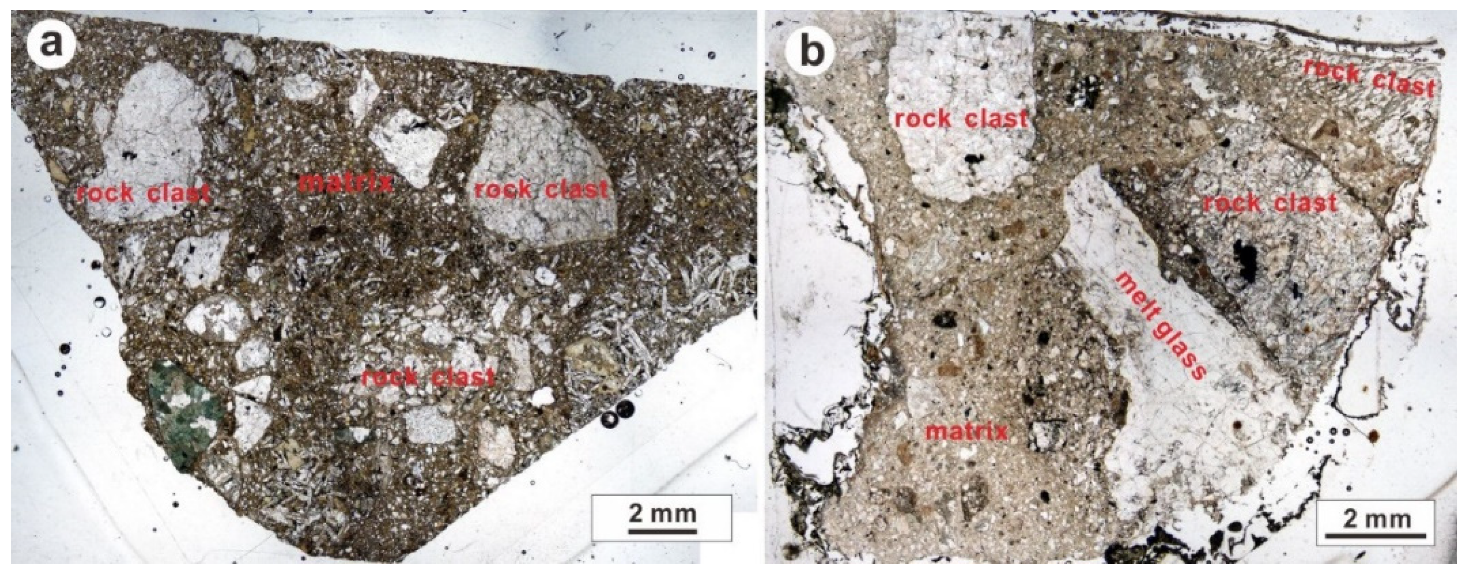
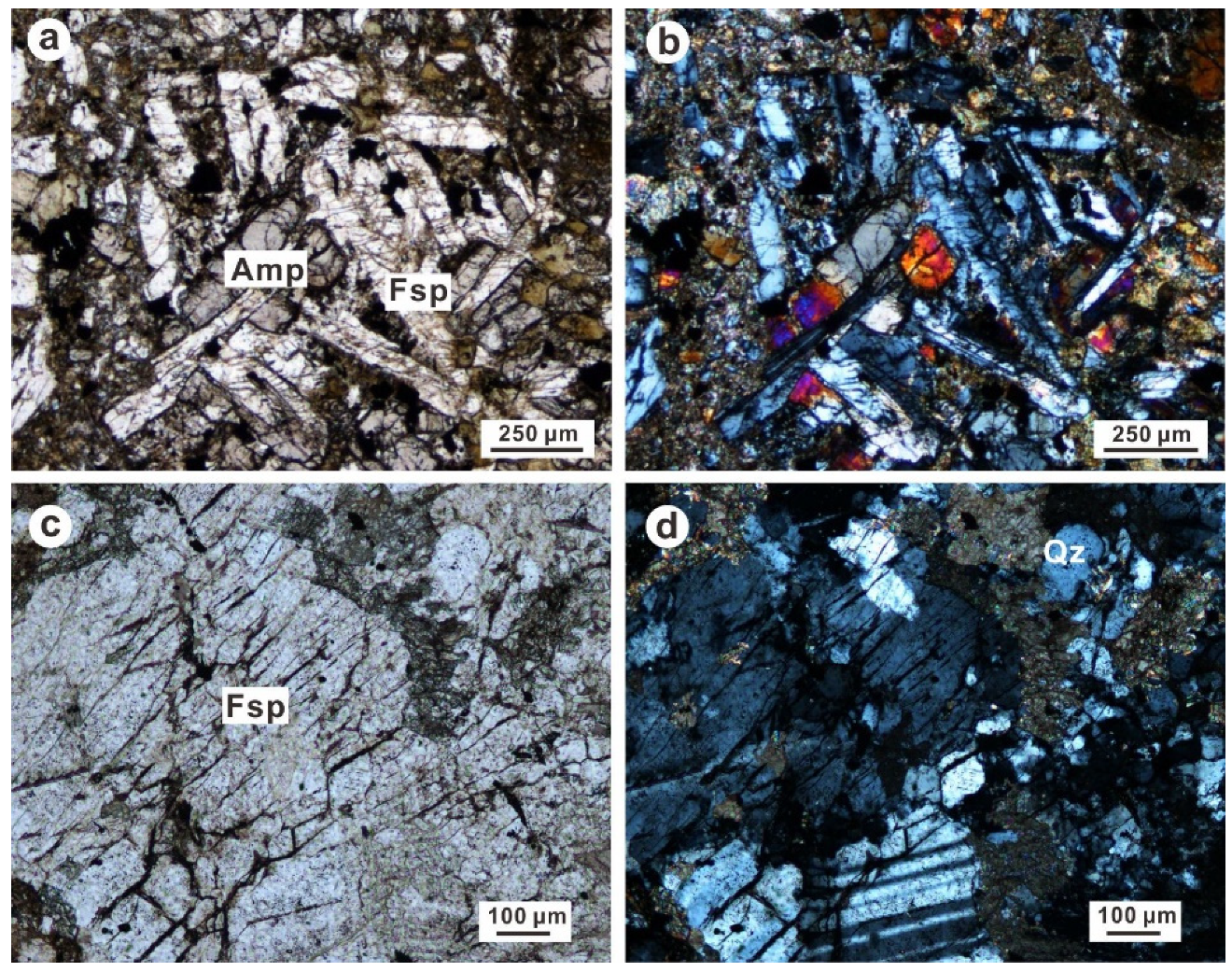
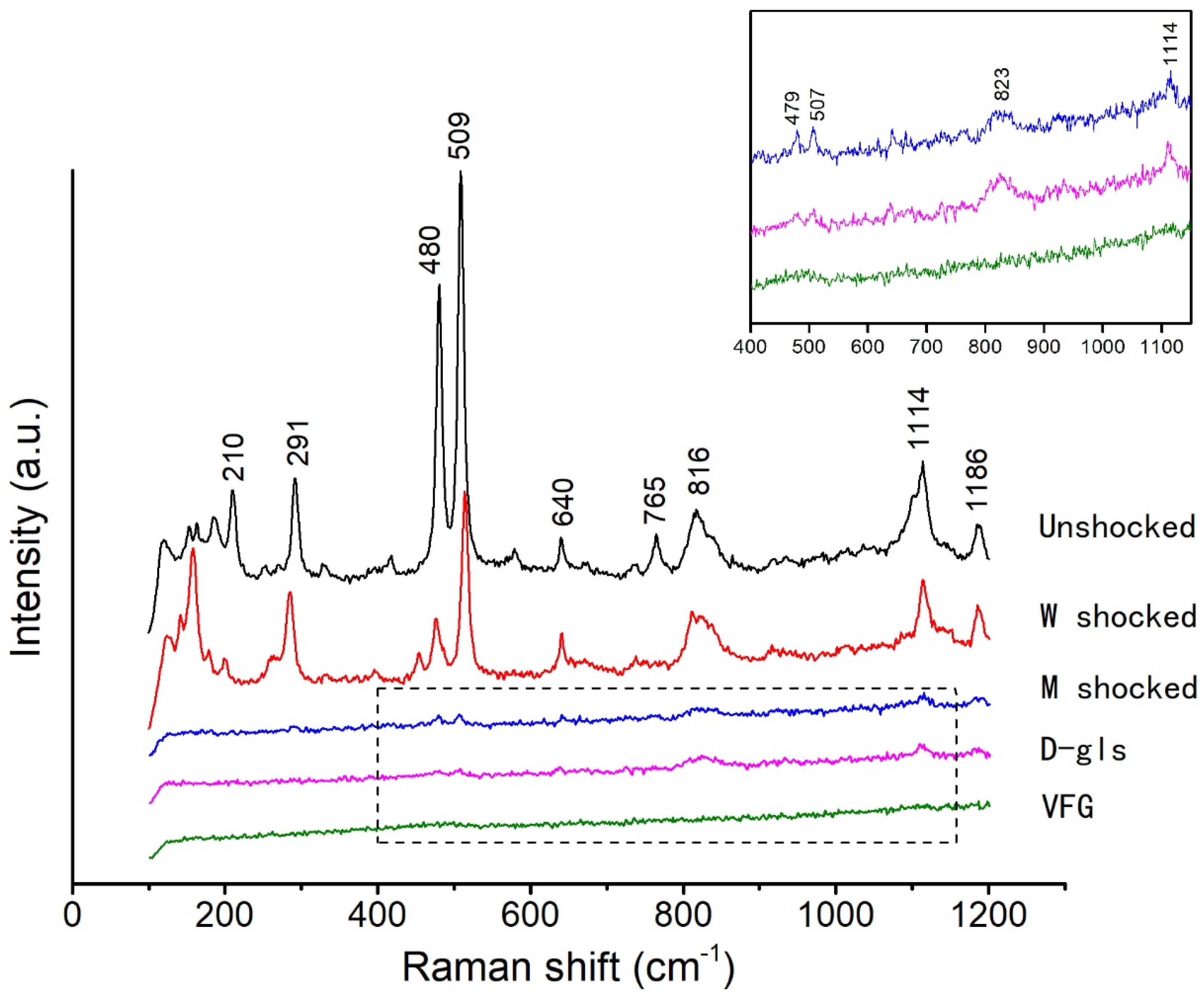
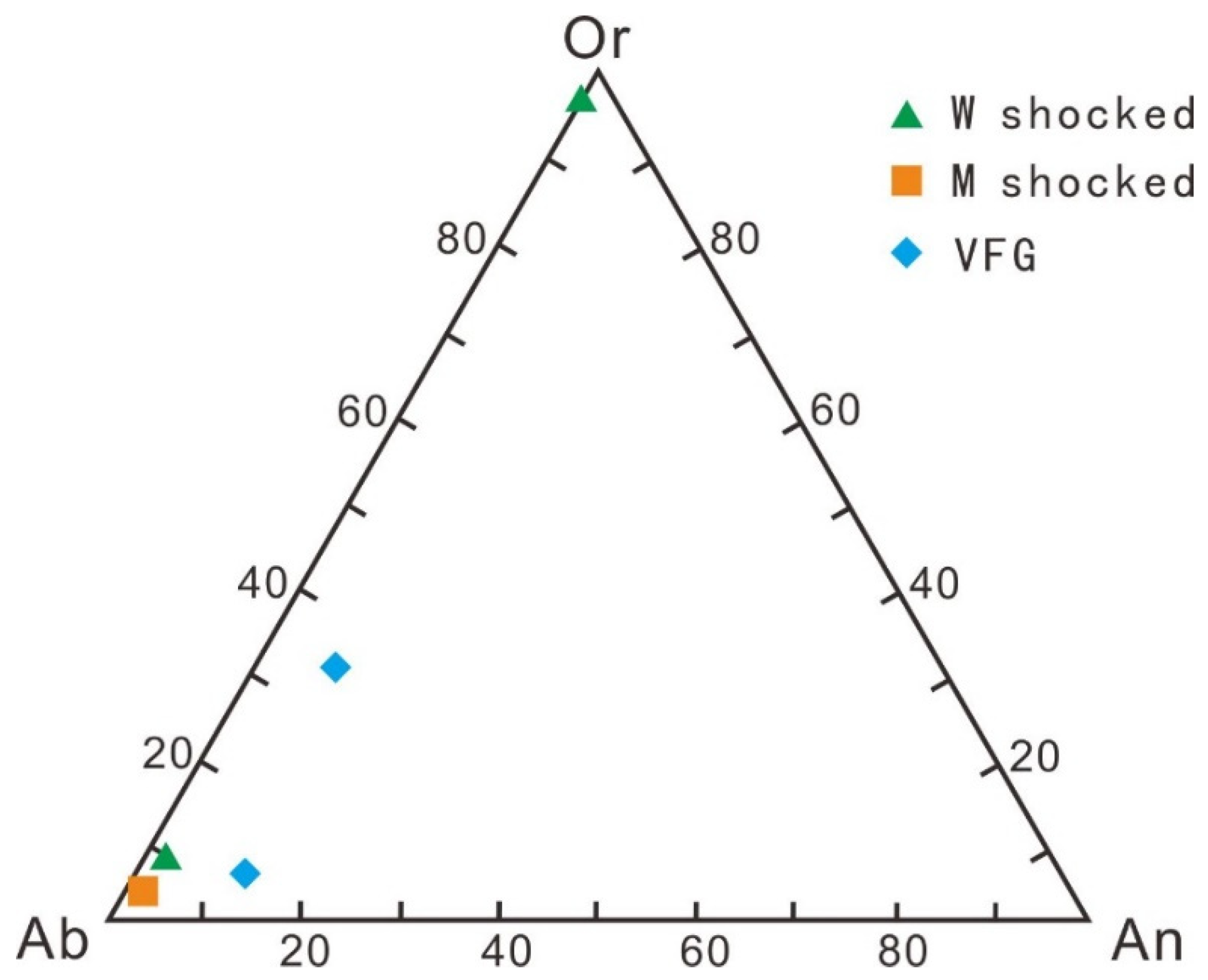
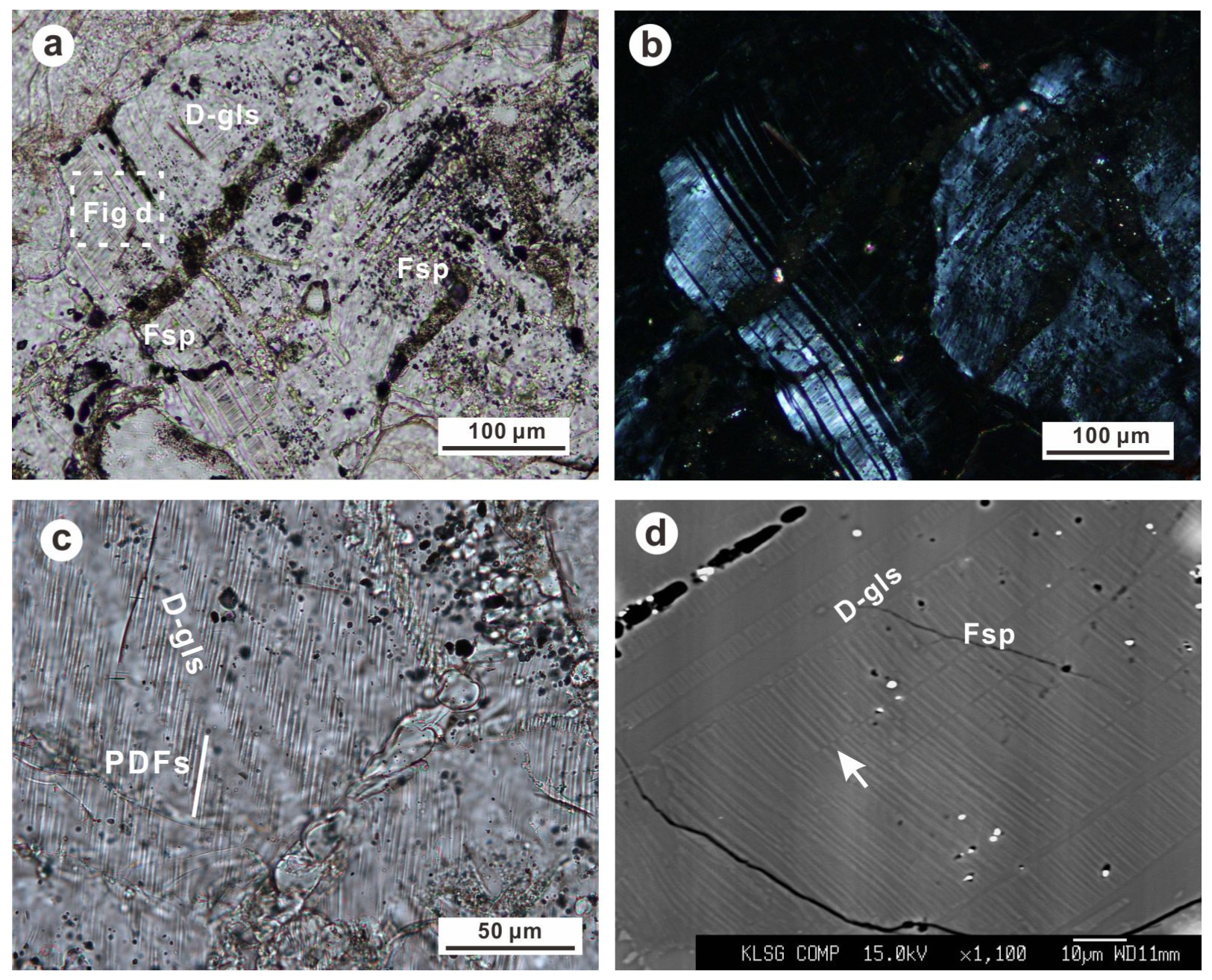
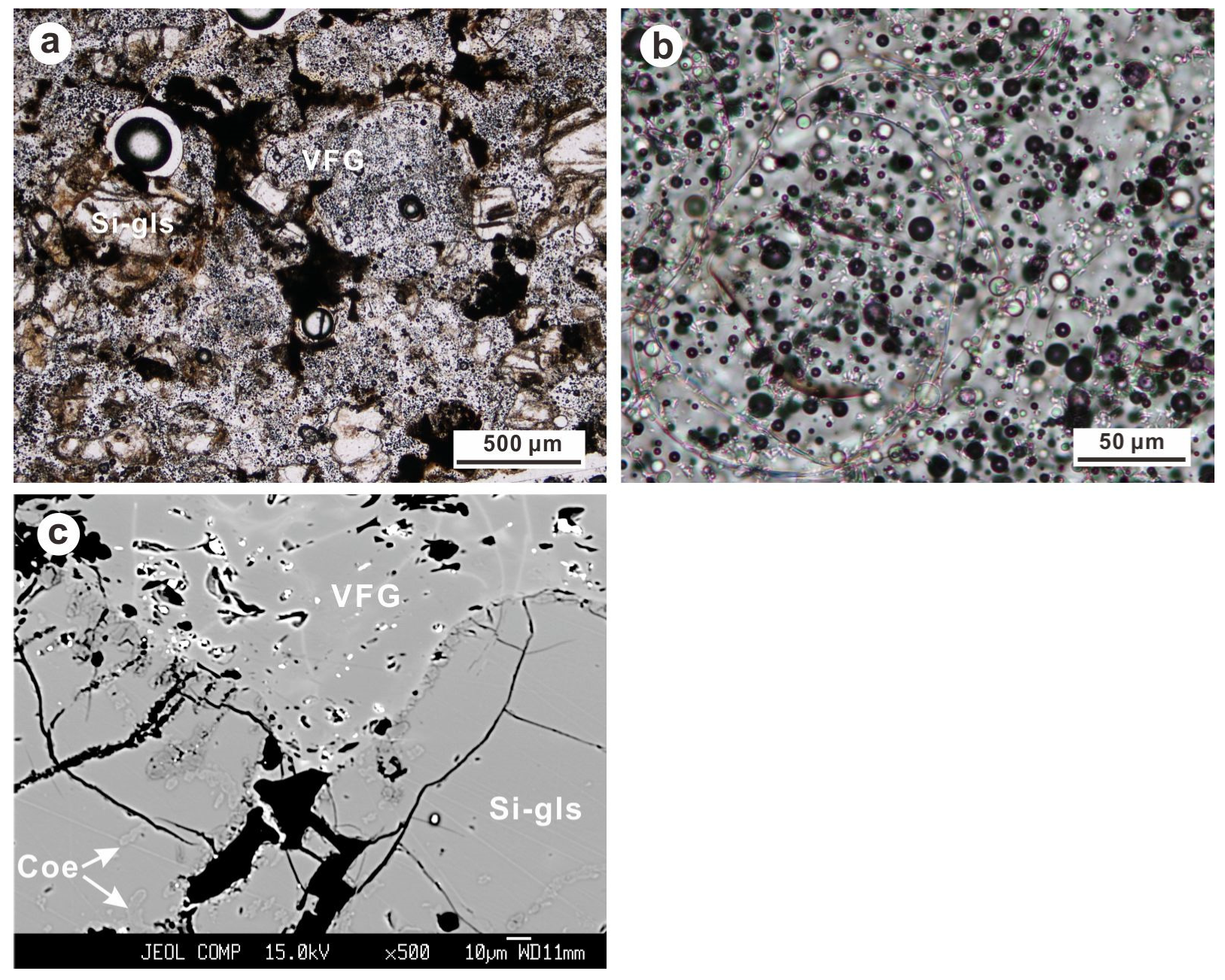
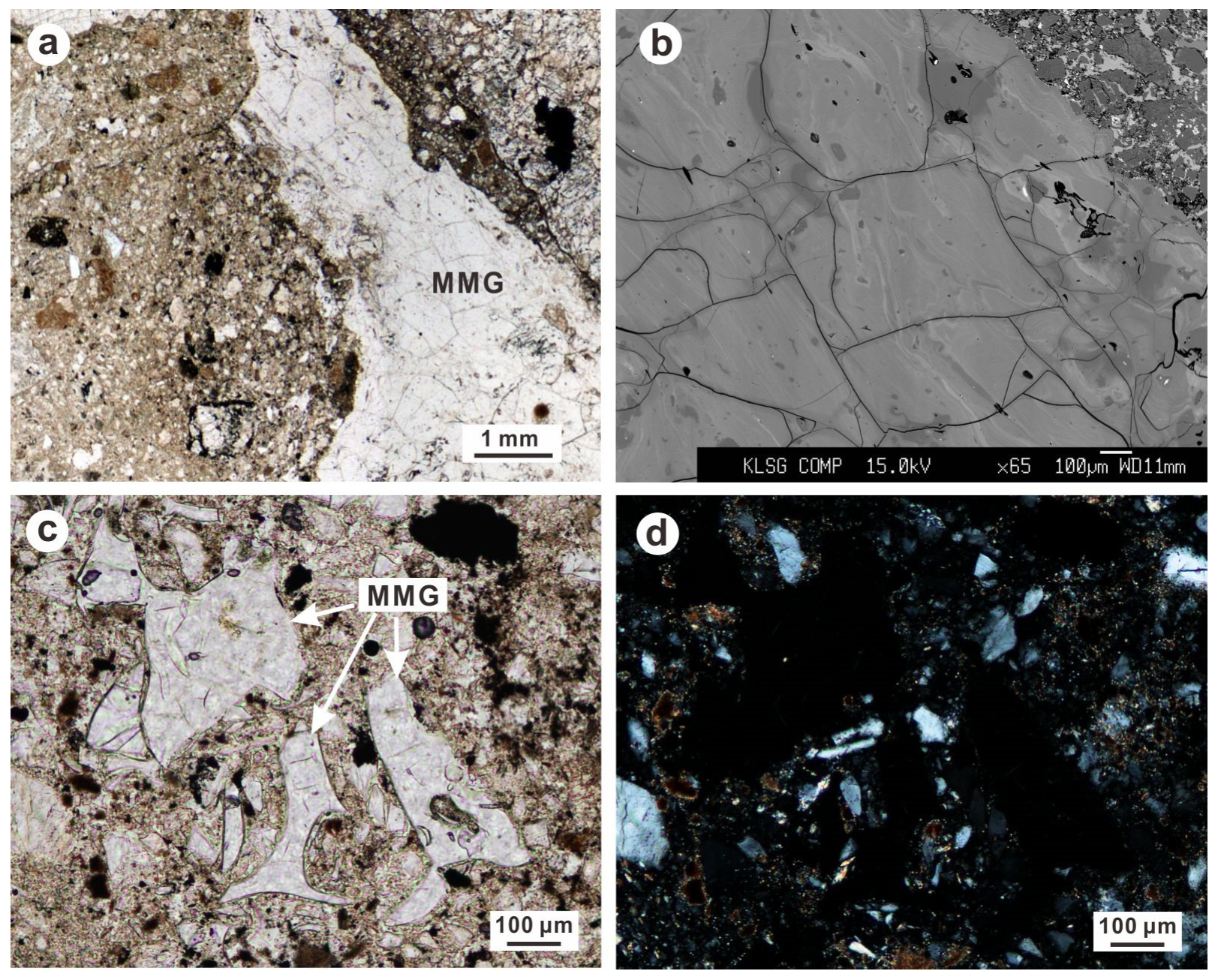
| Oxide (wt%) | Weakly Shocked | Moderately Shocked | Melt Glasses | |||||
|---|---|---|---|---|---|---|---|---|
| D-gls | Crystalline | VFG | MMG | |||||
| SiO2 | 64.53 | 68.90 | 71.03 | 69.88 | 75.33 | 66.46 | 69.17 | 55.15 |
| TiO2 | - | 0.00 | 0.01 | - | - | 0.03 | 0.47 | 0.64 |
| Al2O3 | 18.48 | 19.62 | 19.47 | 19.22 | 18.41 | 19.74 | 13.90 | 19.75 |
| FeO | 0.08 | 0.05 | 0.06 | 0.12 | 0.12 | 0.68 | 5.25 | 7.60 |
| MnO | 0.04 | - | 0.00 | 0.02 | 0.03 | 0.01 | 0.07 | 0.18 |
| MgO | 0.01 | 0.01 | 0.01 | 0.00 | 0.01 | 0.09 | 1.88 | 4.18 |
| CaO | 0.00 | 0.32 | 0.17 | 0.25 | 0.14 | 0.96 | 2.55 | 6.39 |
| Na2O | 0.45 | 8.61 | 8.09 | 8.78 | 1.10 | 6.60 | 1.22 | 0.19 |
| K2O | 16.32 | 1.15 | 0.43 | 0.36 | 0.83 | 0.56 | 2.20 | 3.50 |
| P2O5 | - | 0.00 | 0.02 | 0.02 | - | 0.01 | 0.04 | 0.03 |
| Total | 99.91 | 98.66 | 99.29 | 98.65 | 95.98 | 95.14 | 96.75 | 97.60 |
| An | 0.0 | 3.6 | 2.2 | 3.0 | 8.6 | 13.2 | ||
| Ab | 4.0 | 88.6 | 94.5 | 94.5 | 61.0 | 82.2 | ||
| Or | 96.0 | 7.8 | 3.3 | 2.6 | 30.4 | 4.6 | ||
© 2020 by the authors. Licensee MDPI, Basel, Switzerland. This article is an open access article distributed under the terms and conditions of the Creative Commons Attribution (CC BY) license (http://creativecommons.org/licenses/by/4.0/).
Share and Cite
Yin, F.; Dai, D. A Study of Shock-Metamorphic Features of Feldspars from the Xiuyan Impact Crater. Minerals 2020, 10, 231. https://doi.org/10.3390/min10030231
Yin F, Dai D. A Study of Shock-Metamorphic Features of Feldspars from the Xiuyan Impact Crater. Minerals. 2020; 10(3):231. https://doi.org/10.3390/min10030231
Chicago/Turabian StyleYin, Feng, and Deqiu Dai. 2020. "A Study of Shock-Metamorphic Features of Feldspars from the Xiuyan Impact Crater" Minerals 10, no. 3: 231. https://doi.org/10.3390/min10030231
APA StyleYin, F., & Dai, D. (2020). A Study of Shock-Metamorphic Features of Feldspars from the Xiuyan Impact Crater. Minerals, 10(3), 231. https://doi.org/10.3390/min10030231





